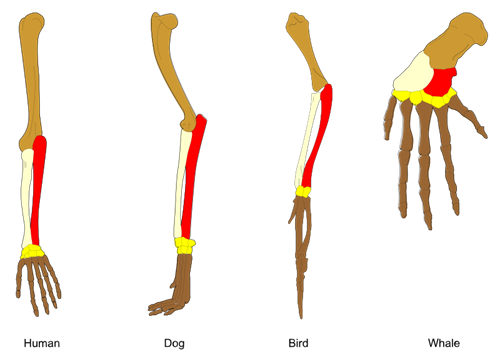
PUMPA - SMART LEARNING
எங்கள் ஆசிரியர்களுடன் 1-ஆன்-1 ஆலோசனை நேரத்தைப் பெறுங்கள். டாப்பர் ஆவதற்கு நாங்கள் பயிற்சி அளிப்போம்
Book Free DemoBiological or organic evolution occurred due to the series of changes in the characteristics of groups of organisms throughout generations.
Biological evolution can be classified into two types:
- Convergent evolution: It is a evolution in which different species evolve similarities in their characteristics and functions due to the adaptation to a particular environment.
- Divergent evolution: It is a process in which the ancestral species diverges into multiple different species, ultimately giving rise to new species due to the accumulation of differences between the groups.
Important!
Adaptive radiation:
It is the diversification of a species into different forms to adapt to different environmental conditions for their survival.
This evolution can be better understood only by observing the interrelationships between living animals and comparing parallels to extinct organisms. Evidence from other disciplines of biology also supports the interrelationship of the creatures. These facts back up the theory that all species have descended from a common ancestor.
The three major evidences that prove biological evolution are as follows:
- Evidences from morphology and anatomy
- Evidences from embryology
- Evidences from palaeontology
1. Evidences from morphology and anatomy
These are the evidence that includes comparing anatomical and morphological characters and thereby prove that they possess a common set of characteristics.
Based on the structural and functional similarities and variations, these are studied under various categories as follows:
- Homologous organs
- Analogous organs
- Vestigial organs
- Atavism
The organs from various animals or plants with a similar structure, identical developmental origin, and diverse functions are known as homologous organs.
These organs of different organisms may have similar basic anatomical structures as they are inherited from a common ancestor with similar developmental patterns in embryos. But they have different morphological features and functions.
As previously stated, these organs must have evolved from a common ancestor that evolved into organs with various anatomical traits that were appropriate to their distinct habitats. Such types of organs are known as homologous organs, and the term homology refers to common ancestry.
This type of evolution among organisms is known as divergent evolution.

Homologous organs
Mammalian forelimbs are homologous structures. A human hand, a cat's front leg, a whale's flipper, and a bat's wing all have diverse shapes and functions. Their growth patterns and basic bone structure are identical.
Reference:
https://en.wikipedia.org/wiki/Homology_(biology)#/media/File:Homology_vertebrates-en.svg